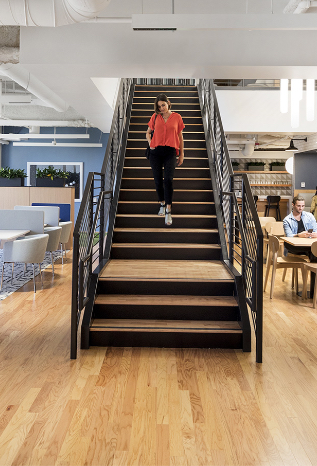Offices exist to get work done – but how to make an office conducive to maximum efficiency and employee wellbeing is a more complex question. Modern office design requires employers and serviced office providers to think beyond lighting and decor to questions of utility, best use of space, and emotional attachment. With this in mind, we take a look at four top tips to improve your office environment and give your business a palpable boost.
Well in a cell
Pioneered in the 1960s by designer Robert Propst, the cellular office layout fell out of fashion with the rise of open-plan workspaces in the early 2000s. However, with new research revealing that we’re 15% less productive and twice as likely to get sick in an open-plan office, attitudes are changing. Cellular office layouts give each employee or small team greater privacy, which can be crucial for client-oriented businesses. They also allow you to isolate distractions such as loud equipment or customer service teams that make and receive frequent phone calls. Best of all, this type of office doesn’t need to be constructed from the ground up. By simply acquiring L-shaped workstations and freestanding office screens, any shared or serviced office space can be made cellular, and the exact layout can be adjusted until a good balance of productivity and employee comfort is achieved.
Get involved
Employee productivity is as closely tied to feeling valued as it is to rewards and benefits. Giving employees a say in office design is a free and simple way to increase employee engagement and make every member of staff feel respected and listened to. This will eventually lead to greater employee retention and a higher quality of new applicants, which translates into tangible cost savings. To involve employees, the simplest solution is to set up an office committee. Include staff from all levels of the business, and allow employees to select their own representatives. This committee can then air staff views on physical layout, amenities such as stationary and refreshments, access concerns, and social issues. In a serviced or shared office, this can be extended to include representatives of the office provider, allowing the latter to receive vital client feedback and advise on the feasibility of suggestions made.
Pride of place
Teabag stains on walls and stacks of paper on every desk might appeal to those who yearn for the gritty atmosphere of a 1980s newsdesk, but thankfully modern office design trends have moved on. Establishing a culture of neatness and cleanliness can feel a bit anal, but it pays dividends in terms of calm, productive employees. For a client-facing business, this is a no-brainer – your clients will judge you on your office just as much as your work if they ever have to visit in person. Put in place simple rules such as where food should be stored and how desks should be left overnight, but avoid going too far the other way – former Wired Editor Scott Dadich was roundly mocked for his open letter to staff when the magazine moved to a new office in San Francisco. The key is encouraging employees to feel a sense of pride in the workplace, without discouraging a natural amount of creative clutter.
Nice to meet you
Meeting rooms were once considered an essential aspect of office design. However, with reliable connectivity solutions such as a fast internet connection and a good webcam, most modern businesses have little need for a dedicated space. Indeed, meetings have become something of a negative element in many offices, with Atlassian data revealing that 39% of employees have slept in a meeting, and 47% see them as the biggest waste of time in their day-to-day jobs. Dispensing with meeting spaces free up room for informal social spaces, which can be a key lure for new staff, particularly millennials, who research has revealed prefer experiences to physical things. When a meeting space is needed, serviced office providers offer the perfect solution: fully equipped meeting rooms that can be hired for as long as you need, often with the option of a dedicated meeting planner and backup spaces in case anything goes wrong.

